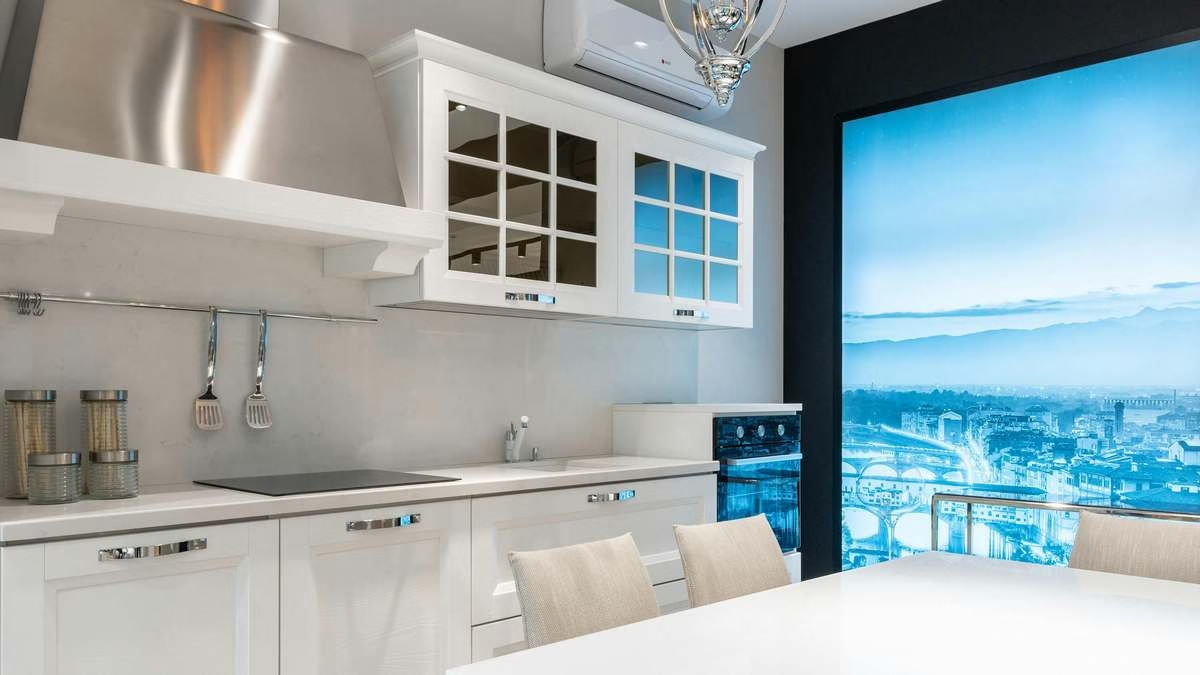Confused about ducted vs ductless range hoods? We compare performance, installation, cost, and efficiency to help you choose the best option for your space.
Table of Contents
Introduction: Clearing the Air in Your Kitchen
Picture this. You just cooked a steak. Your kitchen is full of smoky, smelly air. Without a good fan, that air stays. It holds grease and smells. These stick to your curtains, walls, and cabinets. This common problem shows why a good range hood matters. But when you need to pick one, you face a big question. Should you choose a ducted or ductless range hood?
This choice is important. It affects your kitchen’s air, your comfort when cooking, and how clean your home stays. A ducted hood, or vented hood, works like an open window. It pushes air outside. A ductless hood, or recirculating hood, works like an air cleaner. It filters the air and blows it back into the room. See here for details instructions on duct-less range hood.
This guide will explain both types. We will look at how they work. We will compare how well they perform. We will talk about cost and installation. By the end, you will know enough to choose the best hood for your cooking, your kitchen, and your wallet. Let’s solve the ducted vs. ductless question for good.
Chapter 1: How Do They Work?
First, let’s see how each system works.
What is a Ducted Range Hood?
A ducted range hood is the best for ventilation. It connects to pipes (ducts) that lead the air from the hood to the outside of your house.
- How it Works: You turn on the fan. It pulls air, smoke, steam, and grease from your stove. This dirty air is sent through the pipes and pushed outside. It removes the air completely.
- The Key Part: The pipe system is key. Stiff metal pipes work best. Bendy pipes are easier to put in but don’t work as well. The path outside should be short and straight for good power.
What is a Ductless Range Hood?
A ductless range hood does not need pipes to the outside. It cleans the air inside your kitchen and blows it back.
- How it Works: The hood still sucks in the cooking air. But the air does not go outside. Instead, it goes through filters. First, a metal filter catches grease. Then, a charcoal filter takes out smells. The “clean” air is then blown back into the kitchen.
- The Key Part: The charcoal filters are the most important part. You cannot reuse them. They get weak over time. You need to put in new ones every 3 to 6 months, based on how much you cook.
Chapter 2: Ducted vs. Ductless: A Comparison
Now, let’s compare the two systems.
Performance and Air Quality
This is the biggest difference.
- Ducted (Vented):
- Performance: The best. Ducted hoods are great at removing smoke, steam, heat, and grease. They can handle strong cooking like frying.
- Air Quality: Gives you the best air. It takes the bad stuff out of your home. This is good for people with allergies or asthma.
- Ductless (Recirculating):
- Performance: Limited. New ductless hoods are better, but they cannot remove heat or wetness. Charcoal filters can cut smells, but strong smells like fish may remain. The air goes back into the room, which can feel hot and damp.
- Air Quality: Makes air better by catching some grease and smells. But it does not fix wetness or heat.
Verdict: For power, ducted hoods win.
Installation and Flexibility
How easy it is to put in is a big factor.
- Ducted (Vented):
- Installation: Hard and messy. You need to cut holes in walls or ceilings to run the pipes outside. You often need a pro to help, mainly in big homes.
- Flexibility: Low. You must put it where the pipes can go. Adding one to a home that did not have one can be a big job.
- Ductless (Recirculating):
- Installation: Simple and fast. You don’t need pipes. You can often do it yourself. Just fix the hood to the wall and plug it in.
- Flexibility: High. You can put a ductless hood almost anywhere. It is the only choice for apartments or homes where you can’t add pipes.
Verdict: For easy setup, ductless hoods win.
Cost: Now and Later
The price is more than just the hood.
- Ducted (Vented):
- Cost Now: Higher. The hood may cost the same, but you pay for pipes and maybe a pro to install it.
- Cost Later: Lower. No filters to buy. You just wash the metal grease filter now and then.
- Ductless (Recirculating):
- Cost Now: Lower. The unit and setup are usually cheaper.
- Cost Later: Higher. You must buy new charcoal filters 2 to 4 times a year. This adds cost over time.
Verdict: Ductless costs less now. Ducted costs less over time.
Maintenance and Care
- Ducted (Vented): Easy to care for. Wash the metal filters every month or two. Wipe the outside of the hood.
- Ductless (Recirculating): Needs more care. You must wash the metal filters and change the charcoal filters on time. If you don’t change the charcoal filter, the hood stops working well. You might need to read this Full Guide: How to Install a Ductless Under-Cabinet Hood.
Verdict: Ducted hoods need less care.
Noise Levels
- Ducted (Vented): Often quieter. The air has a clear path out, so the motor does not work as hard.
- Ductless (Recirculating): Can be louder. The air must push through the thick charcoal filters. The motor works harder and makes more noise.
Verdict: Ducted hoods are often quieter.
Chapter 3: The Convertible Hood: The Best of Both?
Some new hoods are called “convertible.” This means you can set them up as ducted or ductless.
- How it Works: The hood has a spot for a pipe. It also comes with a cover for that spot if you go ductless. You buy a charcoal filter kit to use it as a ductless hood.
- Is It a True Compromise? It gives you a choice for setup. But it does not change how it works. A convertible hood set as ductless will work like any ductless hood. It will not be as strong as a ducted one. The big plus is that you can change it later if you move.
Chapter 4: How to Choose: A Simple Guide
Still not sure? Ask yourself these questions.
1. How Do You Cook?
- You need a DUCTED hood if: You cook a lot. You often fry, sear, or use a gas stove. You need to remove strong heat, steam, and smells.
- A DUCTLESS hood may be enough if: You do light cooking. You boil water, bake, or use an electric stove. You just want to reduce light smells.
2. What is Your Kitchen Like?
- You need a DUCTED hood if: Your kitchen is on an outside wall. Or you are doing a big remodel where you can add pipes.
- A DUCTLESS hood is your best bet if: You live in an apartment or rental. Your kitchen is inside with no way to get air outside.
3. What is Your Budget?
- Choose DUCTED for the long term: You have money for the harder setup and want to avoid buying filters later.
- Choose DUCTLESS for less money now: Your budget is tight, and you are okay with buying new filters now and then.
4. How Important is Air Quality?
- Choose DUCTED for health and home: Someone in your home has breathing problems. Or you want to keep your kitchen safe from grease and wetness.
- Choose DUCTLESS for basic cleaning: You need to handle light odors and grease but are not worried about heat or damp air.
Chapter 5: Tips for Your Range Hood
Use these tips to make your hood work its best.
- Get the Right Size: Your hood should be as wide as your stove, or even wider. This helps it catch all the smoke and steam.
- Use the Right Speed: Use a higher fan speed when cooking. Turn the hood on a few minutes before you start. Leave it on for 15 minutes after you finish.
- Take Care of It: Wash metal filters each month. Change charcoal filters every 3 to 6 months. A dirty filter does not work well and can hurt the motor.
- Put It at the Right Height: Most hoods should be 24 to 30 inches above the stove. Check the guide that came with your hood.
I have created a Top 5 best under cabinet range hoods review, hope you might like it.
Conclusion: Making Your Choice
Your choice is about what you value most: top performance or easy setup.
- Choose a Ducted Range Hood for power. It is the best at removing heat, steam, grease, and smells from your home. It is a great long-term buy for your kitchen’s air and your home. The setup is harder, but it works great every day and has no extra costs. Pick this if you love to cook.
- Choose a Ductless Range Hood for a simple fix. It is perfect for apartments or kitchens where pipes can’t go. It costs less at the start and is easy to put in. But know that it has limits, and you must keep buying new filters.
There is no perfect answer for everyone. Think about how you cook, your kitchen’s layout, and your money. Then you can pick the range hood that will keep your kitchen’s air fresh for years.


